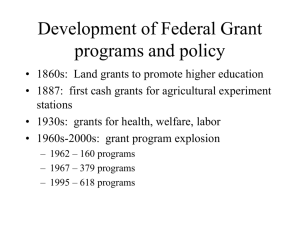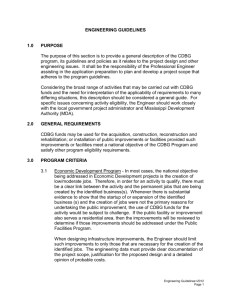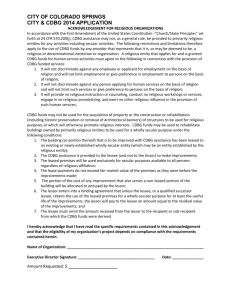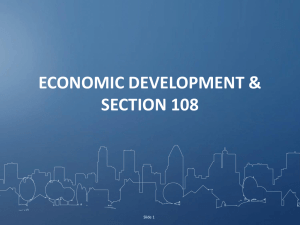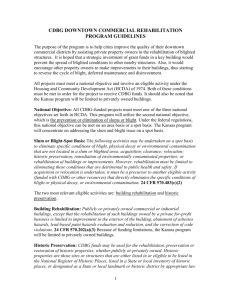2016 ESG RFP Part 4 Section V and Appendix
advertisement
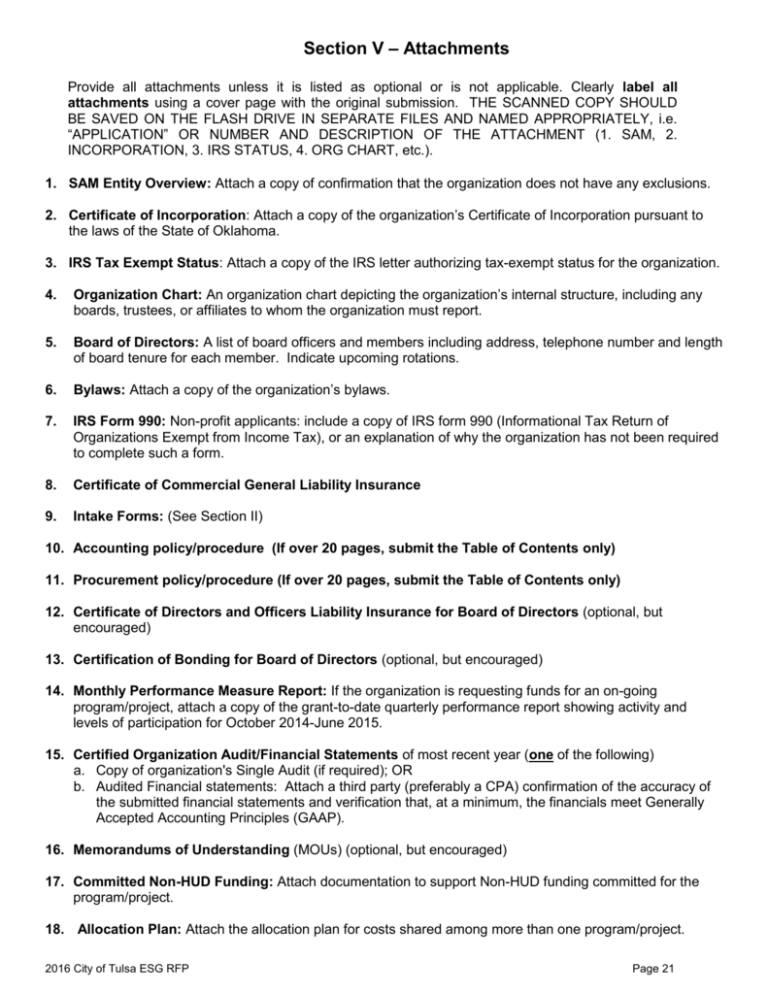
Section V – Attachments Provide all attachments unless it is listed as optional or is not applicable. Clearly label all attachments using a cover page with the original submission. THE SCANNED COPY SHOULD BE SAVED ON THE FLASH DRIVE IN SEPARATE FILES AND NAMED APPROPRIATELY, i.e. “APPLICATION” OR NUMBER AND DESCRIPTION OF THE ATTACHMENT (1. SAM, 2. INCORPORATION, 3. IRS STATUS, 4. ORG CHART, etc.). 1. SAM Entity Overview: Attach a copy of confirmation that the organization does not have any exclusions. 2. Certificate of Incorporation: Attach a copy of the organization’s Certificate of Incorporation pursuant to the laws of the State of Oklahoma. 3. IRS Tax Exempt Status: Attach a copy of the IRS letter authorizing tax-exempt status for the organization. 4. Organization Chart: An organization chart depicting the organization’s internal structure, including any boards, trustees, or affiliates to whom the organization must report. 5. Board of Directors: A list of board officers and members including address, telephone number and length of board tenure for each member. Indicate upcoming rotations. 6. Bylaws: Attach a copy of the organization’s bylaws. 7. IRS Form 990: Non-profit applicants: include a copy of IRS form 990 (Informational Tax Return of Organizations Exempt from Income Tax), or an explanation of why the organization has not been required to complete such a form. 8. Certificate of Commercial General Liability Insurance 9. Intake Forms: (See Section II) 10. Accounting policy/procedure (If over 20 pages, submit the Table of Contents only) 11. Procurement policy/procedure (If over 20 pages, submit the Table of Contents only) 12. Certificate of Directors and Officers Liability Insurance for Board of Directors (optional, but encouraged) 13. Certification of Bonding for Board of Directors (optional, but encouraged) 14. Monthly Performance Measure Report: If the organization is requesting funds for an on-going program/project, attach a copy of the grant-to-date quarterly performance report showing activity and levels of participation for October 2014-June 2015. 15. Certified Organization Audit/Financial Statements of most recent year (one of the following) a. Copy of organization's Single Audit (if required); OR b. Audited Financial statements: Attach a third party (preferably a CPA) confirmation of the accuracy of the submitted financial statements and verification that, at a minimum, the financials meet Generally Accepted Accounting Principles (GAAP). 16. Memorandums of Understanding (MOUs) (optional, but encouraged) 17. Committed Non-HUD Funding: Attach documentation to support Non-HUD funding committed for the program/project. 18. Allocation Plan: Attach the allocation plan for costs shared among more than one program/project. 2016 City of Tulsa ESG RFP Page 21 Section V – Attachments (continued) ACQUISITION PROJECTS – ATTACHMENTS 19. Option agreement for applicable property acquisition projects 20. Flood plain map with the location identified, including all possible locations 21. Copy of Zoning verification 22. Current Appraisal 23. Documentation of required land use approvals such as Site Review, Annexation, Zone Change, Minor Land Partition, Demolition, or Conditional Use permits 24. Photographs of the property 25. Most recent property inspection report and/or capital needs assessment 26. URA Notice which includes date distributed to occupants (if applicable) 27. Relocation Plan with timeline and budget (if applicable) 28. Five year Operating Pro Forma (copy of Section IV - Budget Table 4) 29. Timeline (to include project start, project spending and project completion dates) CONSTRUCTION/RENOVATION PROJECTS – ATTACHMENTS 30. Site Control (property deed, executed contract of sale) 31. Flood plain map (project location identified) 32. Copy of Zoning verification 33. Most recent property inspection report and/or capital needs assessment 34. Work write-up detail 35. Cost estimate (Cost must be estimated by a Professional Engineer (PE) licensed in the State of Oklahoma and authorized to sign and seal plans, drawings and costs that will be submitted to a public authority for approval.) 36. Photographs of site to be improved (for rehabilitation projects) 37. Architectural/Engineering schematic 38. Timeline (to include project start, project spending and project completion dates) 39. Five year Operating Pro Forma (copy of Section IV - Budget Table 4) 40. Phase 1 Environmental Assessment (for new construction projects) 41. URA Notice including date distributed to occupants (if applicable) 42. Relocation Plan including timeline and budget (if applicable) 2016 City of Tulsa ESG RFP Page 22 Appendix 1 ESG APPLICATION CHECKLIST Organization ___________________________________ Submitted by __________________________________________ Program/Project Name __________________________ Five-Year Community Goal _________________________________ Category: Prevention Shelter Street Outreach Rapid Rehousing Review the application prior to submission to ensure that the following requirements are met. Applications that do NOT include the following REQUIRED documents will be considered INCOMPLETE. Please confirm the application contains the following components in the order given and all applicable forms are signed and dated by the appropriate representatives. - REQUIRED DOCUMENTS TO MEET QUALIFICATIONS - Executive Summary Grant Certification Form 1 (Federal Regulations) – Signed by a Board Official, Authorized Agency Representative, and Agency Financial Representative Grant Certification Form 2 (Conflict of Interest) – Signed by a Board Official and Authorized Agency Representative Grant Certification Form 3 (Committed Funding) – Signed by a Board Official and Authorized Agency Representative Grant Certification Form 4 (Board Authorization) – Signed by a Board Official Grant Certification Form 5 (For Rehabilitation and New Construction Projects) – Signed by a Board Official and Authorized Agency Representative Sections I – III: Organization Information, Goals and Objectives, and Project/Program Information. Section IV: Financial Information, Pro Forma (if applicable), and Budget Forms (Excel spreadsheets) – Signed by an Authorized Agency Representative and an Agency Financial Representative. Section V: Attachments – All applicable attachments for the proposed project/program are included with the application. PLEASE PLACE THIS COMPLETED CHECKLIST ON TOP OF THE APPLICATION 2016 City of Tulsa ESG RFP Page 23 Appendix 2 FUNDING OPPORTUNITIES – BRIEF ACTIVITY DESCRIPTIONS ACQUISITION AND NEW CONSTRUCTION OF HOUSING Assistance for First-Time Homebuyers (HOME) – Only for the direct financial assistance to households for down payment, closing costs, and interest subsidy assistance; maximum assistance is $5,000 per household. Housing Services (CDBG) – CDBG funds in support of the HOME program are available for project delivery costs for qualifying and processing loans for assistance to First-Time Homebuyers. Staff costs and related expenses required for screening applicants, loan processing, and other services related to delivering a homebuyer assistance program are allowed. Note: Activities under this project must be used in conjunction with the HOME Assistance for First-Time Homebuyers program. New Construction of Multi-Family Rental (HOME) – Rental projects must be planned to ensure that 90% of the residents who reside in HOME-assisted units are no more than 60% Median Family Income (MFI); 20% must be below 50% MFI; and projects must meet accessibility requirements for Federally Assisted Housing. Acquisition and/or Rehabilitation of Multi-Family Rental (HOME) – Rental projects must be planned to ensure that 90% of the residents who reside in HOME-assisted units are no more than 60% MFI; 20% must be below 50% MFI; and projects must meet accessibility requirements for Federally Assisted Housing. CLEARANCE AND DEMOLITION Clearance and Demolition (CDBG) – The demolition of buildings and improvements, the removal of demolition products (rubble) and other debris, or the movement of structures to other sites. ECONOMIC DEVELOPMENT Direct Financial Assistance to For-Profits (CDBG) – Assisting a private, for-profit business for the purpose of creating jobs. Assistance may include grants, loans, loan guarantees, and technical assistance. Microenterprise Assistance (CDBG) – Activities designed to foster the development, support, and expansion of Microenterprise businesses. (A microenterprise is defined as a commercial enterprise that has five or fewer employees, or a person who has expressed an interest and who is, or after an initial screening process is expected to be, actively working toward developing a business that will be a microenterprise at the time it is formed.) 2016 City of Tulsa ESG RFP Page 24 Appendix 2 (continued) EMERGENCY SHELTERS Mental Health Services (CDBG & ESG) – Direct outpatient mental health treatment for targeted populations. Operating Cost of Homeless Program (CDBG & ESG) - Use of funds for operations, maintenance, rent, insurance, repair, security, utilities, fuel, and food for facilities such as emergency shelters. Employment Training (CDBG & ESG) – The provision of job training and employment assistance for individuals experiencing homelessness in an emergency shelters, or for low-income persons through an employment program. HOUSING REHABILITATION Owner Occupied Rehabilitation (CDBG and HOME) – Rehabilitation work includes repairs and/or rehabilitation of owner occupied units. Work must comply with City of Tulsa Rehabilitation Standards and applicable local and state codes. Housing must be the homeowner’s primary residence. Assistance may be structured as a grant or a loan. Note: Requirements for CDBG and HOME may differ. Special Purpose Minor Rehabilitation (CDBG) – Rehabilitation projects that include energy efficiency improvements, handicapped accessibility, and emergency repairs are capped at less than $5,000 per household. Housing Rehabilitation Services (CDBG) – CDBG funds in support of the HOME program are available for project delivery costs for Owner Occupied Rehabilitation projects. Staff costs and related expenses required for outreach and marketing, rehabilitation counseling, screening applicants and structures, preparing work specifications, loan processing, inspections, and other services related to delivering a rehabilitation program. PUBLIC FACILITIES AND INFRASTRUCTURE IMPROVEMENTS Funds may be used for the acquisition (including long-term leases for periods of 15 years or more), construction, reconstruction, or rehabilitation of facilities and real property improvements that are publicly owned or nonprofit owned. Those owned by nonprofits must be operated so as to be open to the general public. Examples of projects include: Neighborhood Facilities (CDBG) - Acquisition, construction, or rehabilitation of facilities that are principally designed to serve a neighborhood and that will be used for social services or for multiple purposes (including recreation). Such facilities may include libraries and community centers. Parks, Recreational Facilities (CDBG) - Development of open space areas or facilities intended primarily for recreational use. Transportation Infrastructure (CDBG) – Sidewalks, bus shelters, street lighting along public transportation routes or to provide access to route from various living facilities. Child Care Centers (CDBG) - Acquisition, construction, or rehabilitation of facilities intended primarily for children age 12 and under. Examples are daycare centers and Head Start preschool centers. 2016 City of Tulsa ESG RFP Page 25 Appendix 2 (continued) PUBLIC SERVICES Funds may be used for a variety of public service programs/projects. Examples include the following: Abused and Neglected Children (CDBG) – Daycare and other services exclusively for abused and neglected children. Battered and Abused Spouses (CDBG) - Services for battered and abused spouses and their families. Crime Awareness (CDBG) – Promotion of crime awareness and prevention, including crime prevention education programs and paying for security guards. Additional security and crime prevention must result in an increased level of existing services provided by the City of Tulsa. Educational Childcare Programs (CDBG) – Services that will benefit children (generally under age 12), including parenting skills classes. Employment Training (CDBG, HOPWA & ESG) – The provision of job training and employment assistance for individuals experiencing homelessness in an emergency shelters, or for low-income persons through an employment program. Food Security (CDBG) – Costs associated with the operation of food banks, community kitchens, and food pantries, such as staff costs, supplies, utilities, maintenance, and insurance. Health Services (CDBG) – Education and other supportive health services for targeted populations. Housing Counseling (CDBG) - Education workshops and individual counseling, and one-on-one financial evaluations. Mental Health Services (CDBG) – Direct outpatient mental health treatment for targeted populations. Operating Cost of Homeless Program (CDBG & ESG) - Use of funds for operations, maintenance, rent, insurance, repair, security, utilities, fuel, and food for facilities such as emergency shelters. Transportation Services (CDBG) – Operating costs for transportation services. Senior Services (CDBG) – Services for the elderly. Street Outreach (ESG) – Essential services necessary to reach out to unsheltered homeless individuals and families, connect them with emergency shelter, housing, or critical services, and provide them with urgent, nonfacility-based care. Component services generally consist of engagement, case management, emergency health and mental health services, and transportation. Youth Services (CDBG) - Educational or recreational activities provided for young people age 13 to 19, such as after school tutoring, mentoring, summer camps, etc. RENTAL HOUSING SUBSIDIES Rental Housing Subsidies (ESG & HOPWA) – Rental housing subsidies for persons experiencing homelessness, low-income persons at-risk of homelessness, including persons with HIV/AIDS. 2016 City of Tulsa ESG RFP Page 26 Appendix 3 Goals, Objectives, Performance Measures, and Outcomes Community Goals and Objectives – Broad guidelines stating general intentions for the use of grant funds Note: These are established by the HUD Community Development Committee with input from various businesses, organizations, and citizens in the community. Program/Project Objectives – General statement that describes what the agency wants to achieve with the program/project. These objectives should be directly related to one of the priorities listed in the Community Goals/Objectives and are generally directly related to the organization’s purpose. Program/Project Performance Measures – Provides the criteria for how the City can evaluate the success of the program/project. Performance Measures should include one or more specific units of measure that directly correlate to the Program/Project Goals, proving the success of the program/project. Performance Measures should also outline the end results and how they are to be tracked and evaluated. Short-Term Goals – Provide a specific, measurable description of what the project is intended to accomplish. Short-term goals should be specific, measurable, attainable, relevant and time-limited. Long-Term Outcomes – Measurable hoped-for effects of accomplishments over a period of time. General Suggestions Be careful not to “over-promise” on what the program/project can realistically deliver or the time frame for implementation. Do not project serving hundreds of individuals if staffing and budget simply will not enable the agency to do so. Should the project be funded, Performance Measures will be used as the basis for drafting a contract and as a framework for monitoring program performance. Because these projections will be translated directly into a written agreement scope of work and into the reporting requirements that are part of the monitoring process, it is important to be realistic. A useful way of making goals more powerful and measurable is to use the SMART mnemonic. While there are numerous variants, S.M.A.R.T. usually stands for: S Specific M Measurable A Attainable R Relevant T Time-bound EXAMPLE 1 Community Goal/Objective: Improve access to affordable housing for homeowners Program/Project Objective: Increase the ability of low to moderate-income individuals to become homeowners Performance Measures: Short-Term Goal: Provide First-Time Homebuyer Education Seminars to 300 low to moderate-income households from July 1st through June 30th. Long-Term Outcome: 30% of the individuals who participate in the First-Time Homebuyer Education Seminars will improve their credit ratings by 100 points and become homeowners. EXAMPLE 2 Community Goal/Objective: Early childhood education and youth activities Program/Project Objective: Prepare youth for success in school Performance Measures: Short-Term Goal: Provide a reading and math summer camp program for 30 children from July 1st through August 15th. Long-Term Outcome: At the end of the camp, 75% of the children who participate will perform above their grade level based on pre and post-testing results as measured by the XYZ Assessment. 2016 City of Tulsa ESG RFP Page 27 Appendix 3 Goals, Objectives, Performance Measures, and Outcomes This worksheet is to help create objectives, goals and outcomes. This form should NOT be submitted with the application. Worksheet Community Goal/Objective Program/Project Objective Short-Term Goals Long-Term Outcomes 2016 City of Tulsa ESG RFP Page 28 2016 City of Tulsa ESG RFP Page 29 Appendix 4 - Maps Tulsa City Council Districts 2016 City of Tulsa ESG RFP Page 30
